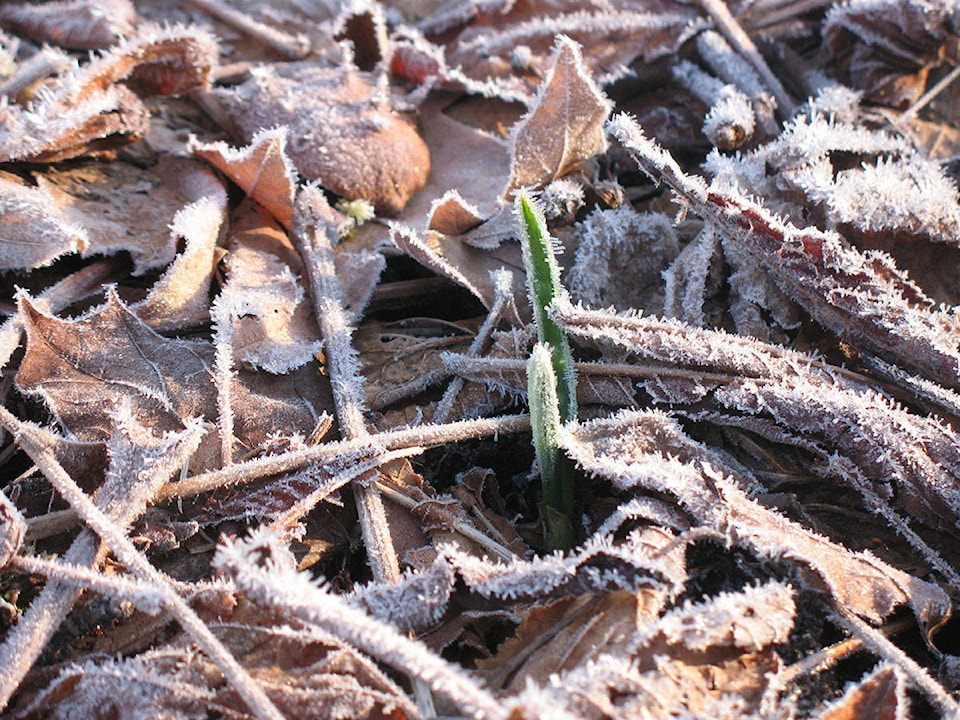By Mary Lowther
David once had a neighbour who moved to Vancouver Island from Saskatchewan, a genuinely nice fellow who would stand at the fence and chat while both men avoided yard work. One day he told David he had sold his house and was moving back to Moose Jaw and, having been there, David was moved to ask why.
“It’s too green here,” was the reply.
Yes, it is green here, which is why we can grow winter crops under protection and harvest outdoor hardy crops year round but despite this, spring is when gardeners really bloom. We endure the elements, fortified by the knowledge that soon we can put away the wellies and long johns and feel truly enthusiastic about a day in the garden. We are sustained by the rituals of the seasons.
For example, snow tires come off at the end of this month, promising warmer weather when I can remove the mulch from the garlic beds I planted last fall. I don’t normally mulch, because in this climate the leaves can provide an ideal cover for insect predation, but when the Dodds sold me their terrific garlic they said they’ve been doing it for years I figured that this year I’d give it a try.
Once the sun drives off the rain and clouds I’ll rake the leaves off the beds to warm the soil and encourage quicker garlic growth. I learned a long time ago (from an old gardener who was probably younger than I am today) not to water garlic, but recent hot dry summers have forced me to reconsider. I’ll wait until the soil has warmed up nicely and then cover the beds with fresh mulch and see how much evaporation that prevents before I consider watering them.
In the meantime, once the winter leaf mulch is raked off, I’ll fertilize the bed with Solomon’s mix at the rate of two quarts per hundred square feet as growing plants need extra nutrients, giving them a good spray of compost tea in about a month to boost immunity and help ward off diseases.
Spring also means it is time to transplant our asparagus into a freshly cleared bed in the property down the road and that’s all I have to say about that, for now. David has calculated that we have room for 60 beds, three feet wide by 70 long; so far we have five planted and a long, long way to go.
David has been chomping at the bit to grow vegetables over there ever since he bought the land and spent the last five years cutting trees, clearing brush, levelling and fencing, but I explained we had to build up the soil first. The best way to do this is by planting cover crop, cutting it down, leaving it to rot, plowing it under and repeating the process. Patience is not David’s strong suit; when he was a child he used to dig up his peas every day to see if they were sprouting yet!
He also bought a truckload of composted chicken manure and built two compost heaps that cover about 100 square feet and started out about four feet high. Most of those leaves came from the parks crew, generously mixed with a contribution from Pat Thomson’s horse, but David says if we need more we can always shred old budget speeches from Hansard. It doesn’t matter which party was in power because it all ends up looking like it fell from the hind end of an equine.
He also warns me that from now on I should be buying my supplies by the pallet, which is why he built me the barn that he promptly filled with all of his tools, to the point where he had to build another shelter for the tractor. I’m not sure how I’m going to go about fermenting enough compost tea for half an acre, but fearless, trusting David assures me it can be done. I am afraid to ask how. When we met he warned me he was looking for a “tempestuous relationship and regular feeding” but never mentioned his methods.
When he was proof reading this column David asked me to point out that he had a lot of help preparing the site. Bruce Lamb felled 200 trees and Wayne Ferris helped trim them and bust the brush. Lyle and the boys at Ridgeline chipped 1,000 branches and Keith Christie deep plowed the land and pulled the roots. Don I’Anson helped him learn tractor and Jim Neiser taught him to use a chainsaw without self amputation. Gord Closson built the fence, Denis Pilon the barn and pergola, while Bob Day helped with the compost heap. It may take a village to raise a child but it took a small army to grow my garlic.
Thank you one and all.
Please contact mary_lowther@yahoo.ca with questions and suggestions since I need all the help I can get.
